Abstract
A pentachlorophenol (PCP)-degrading Flavobacterium sp. (strain ATCC 39723) degraded bromoxynil with the production of bromide and cyanide. No aromatic intermediates were detected in the spent culture fluid. The cyanide produced upon bromoxynil metabolism was inhibitory to the Flavobacterium sp. Whole cells degraded PCP more rapidly than they did bromoxynil. Bromoxynil metabolism and PCP metabolism were coinduced, either substrate serving as the inducer. Purified PCP hydroxylase degraded bromoxynil with stoichiometric accumulation of cyanide and without bromide production. A product accumulated which was more hydrophilic than bromoxynil upon high-pressure liquid chromatographic analysis and which, when analyzed by gas chromatography-mass spectrometry, had a mass spectrum consistent with that expected for dibromohydroquinone. PCP hydroxylase consumed NADPH, oxygen, and bromoxynil in a 2:1:1 molar ratio, producing 1 mol of cyanide per mol of bromoxynil degraded. We propose a pathway by which bromoxynil is metabolized by the same enzymes which degrade PCP. The initial step in the pathway is the conversion of bromoxynil to 2,6-dibromohydroquinone by PCP hydroxylase. In addition to its utility for decontaminating PCP-polluted sites, the Flavobacterium sp. may be useful for decontaminating bromoxynil spills. This is the first report of cyanide production accompanying the metabolism of a benzonitrile derivative.
Full text
PDF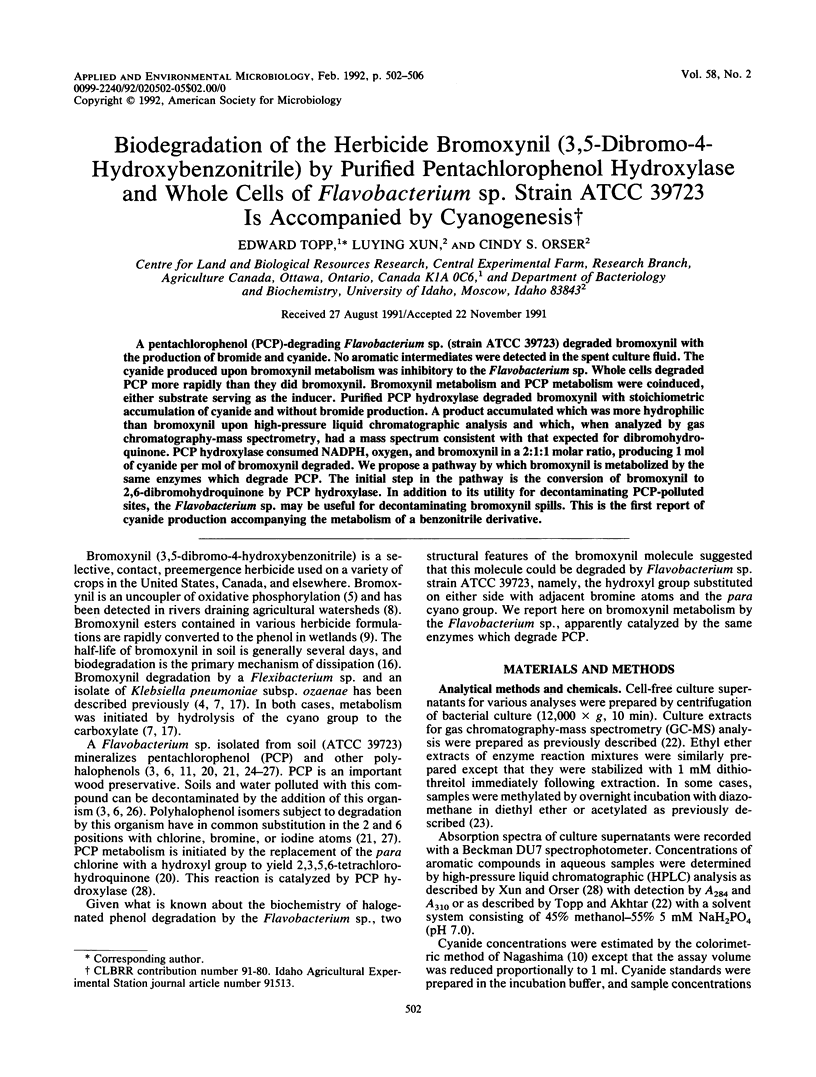
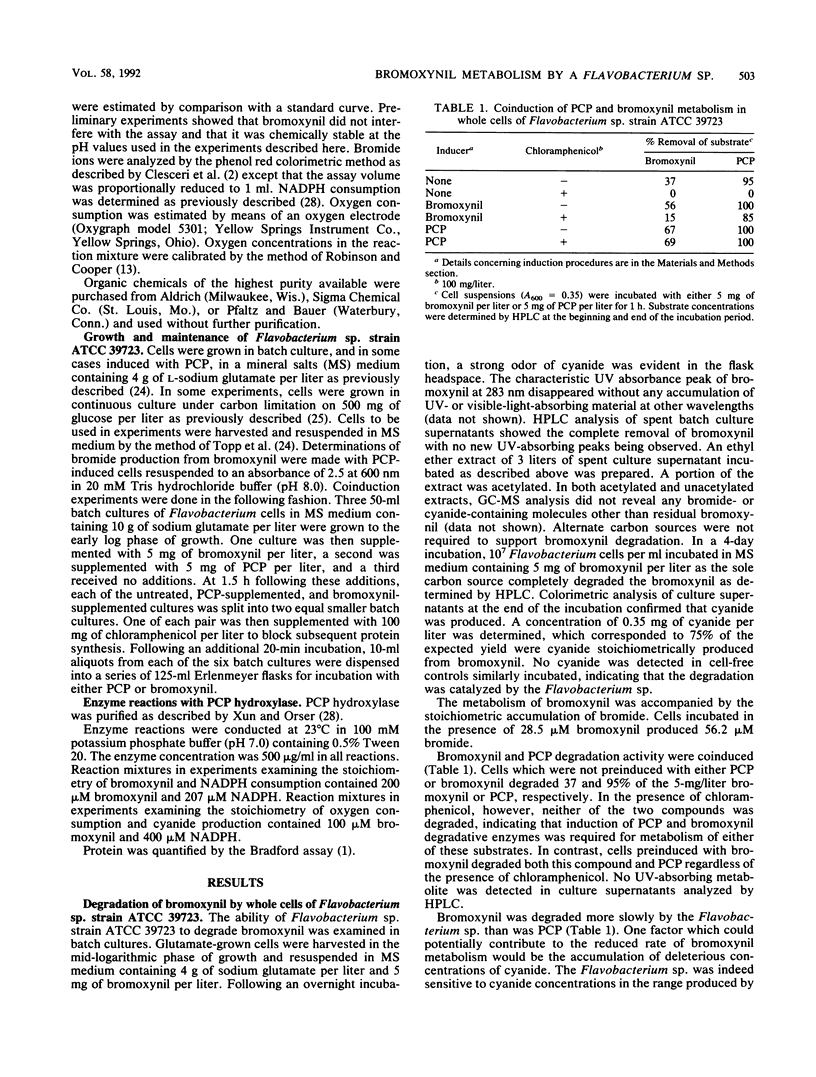
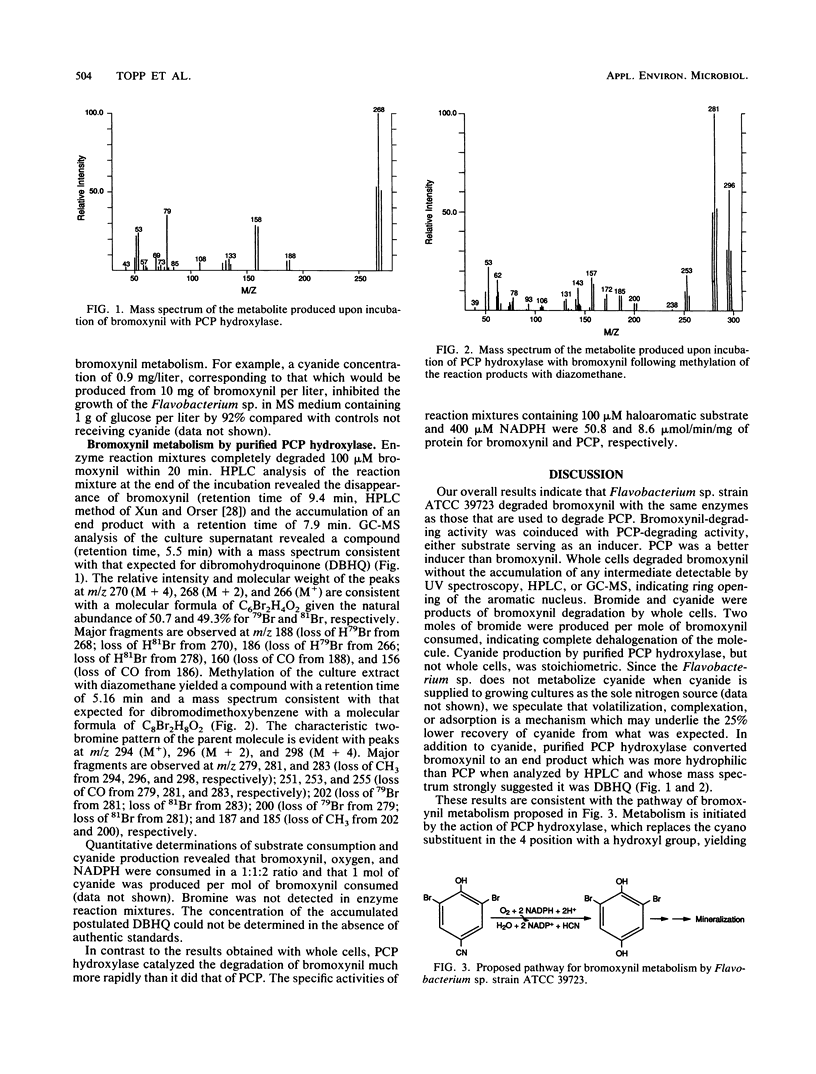
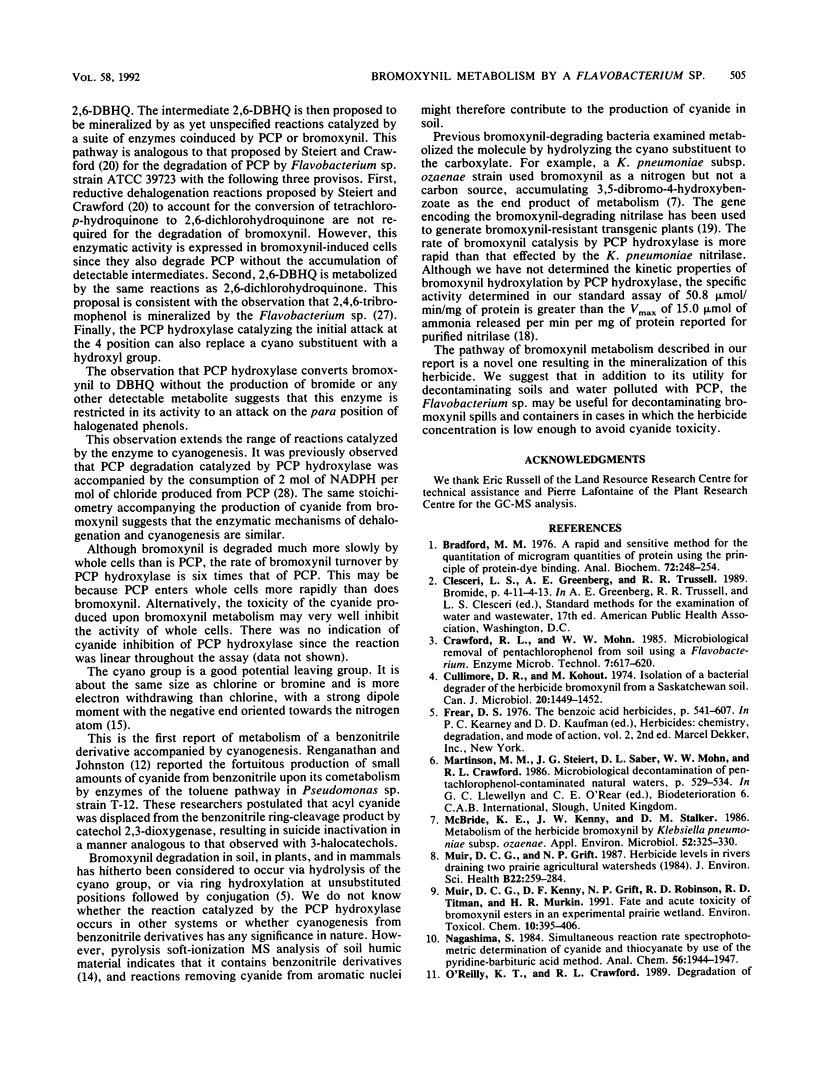
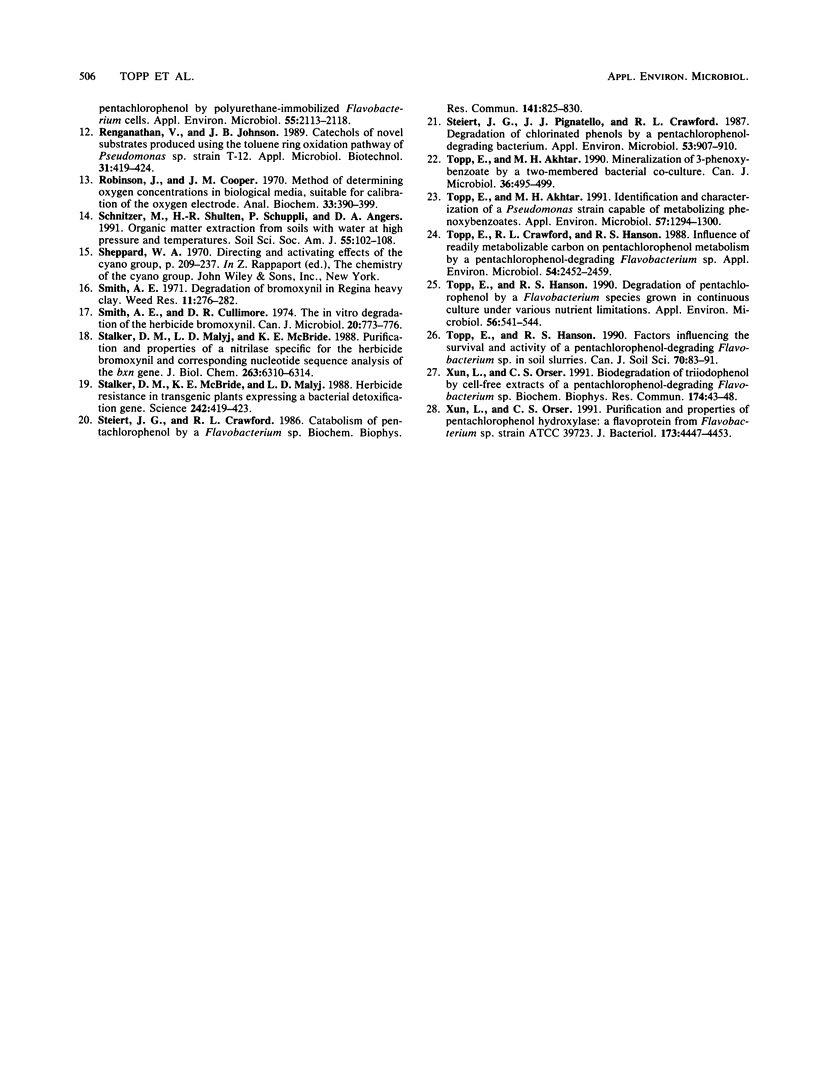
Selected References
These references are in PubMed. This may not be the complete list of references from this article.
- Bradford M. M. A rapid and sensitive method for the quantitation of microgram quantities of protein utilizing the principle of protein-dye binding. Anal Biochem. 1976 May 7;72:248–254. doi: 10.1006/abio.1976.9999. [DOI] [PubMed] [Google Scholar]
- McBride K. E., Kenny J. W., Stalker D. M. Metabolism of the herbicide bromoxynil by Klebsiella pneumoniae subsp. ozaenae. Appl Environ Microbiol. 1986 Aug;52(2):325–330. doi: 10.1128/aem.52.2.325-330.1986. [DOI] [PMC free article] [PubMed] [Google Scholar]
- Muir D. C., Grift N. P. Herbicide levels in rivers draining two prairie agricultural watersheds (1984). J Environ Sci Health B. 1987 Jun;22(3):259–284. doi: 10.1080/03601238709372557. [DOI] [PubMed] [Google Scholar]
- Robinson J., Cooper J. M. Method of determining oxygen concentrations in biological media, suitable for calibration of the oxygen electrode. Anal Biochem. 1970 Feb;33(2):390–399. doi: 10.1016/0003-2697(70)90310-6. [DOI] [PubMed] [Google Scholar]
- Smith A. E., Cullimore D. R. The in vitro degradation of the herbicide bromoxynil. Can J Microbiol. 1974 May;20(5):773–776. doi: 10.1139/m74-119. [DOI] [PubMed] [Google Scholar]
- Stalker D. M., Malyj L. D., McBride K. E. Purification and properties of a nitrilase specific for the herbicide bromoxynil and corresponding nucleotide sequence analysis of the bxn gene. J Biol Chem. 1988 May 5;263(13):6310–6314. [PubMed] [Google Scholar]
- Stalker D. M., McBride K. E., Malyj L. D. Herbicide resistance in transgenic plants expressing a bacterial detoxification gene. Science. 1988 Oct 21;242(4877):419–423. doi: 10.1126/science.242.4877.419. [DOI] [PubMed] [Google Scholar]
- Steiert J. G., Crawford R. L. Catabolism of pentachlorophenol by a Flavobacterium sp. Biochem Biophys Res Commun. 1986 Dec 15;141(2):825–830. doi: 10.1016/s0006-291x(86)80247-9. [DOI] [PubMed] [Google Scholar]
- Steiert J. G., Pignatello J. J., Crawford R. L. Degradation of chlorinated phenols by a pentachlorophenol-degrading bacterium. Appl Environ Microbiol. 1987 May;53(5):907–910. doi: 10.1128/aem.53.5.907-910.1987. [DOI] [PMC free article] [PubMed] [Google Scholar]
- Topp E., Akhtar M. H. Identification and characterization of a pseudomonas strain capable of metabolizing phenoxybenzoates. Appl Environ Microbiol. 1991 May;57(5):1294–1300. doi: 10.1128/aem.57.5.1294-1300.1991. [DOI] [PMC free article] [PubMed] [Google Scholar]
- Topp E., Crawford R. L., Hanson R. S. Influence of readily metabolizable carbon on pentachlorophenol metabolism by a pentachlorophenol-degrading Flavobacterium sp. Appl Environ Microbiol. 1988 Oct;54(10):2452–2459. doi: 10.1128/aem.54.10.2452-2459.1988. [DOI] [PMC free article] [PubMed] [Google Scholar]
- Topp E., Hanson R. S. Degradation of pentachlorophenol by a Flavobacterium species grown in continuous culture under various nutrient limitations. Appl Environ Microbiol. 1990 Feb;56(2):541–544. doi: 10.1128/aem.56.2.541-544.1990. [DOI] [PMC free article] [PubMed] [Google Scholar]
- Xun L., Orser C. S. Biodegradation of triiodophenol by cell-free extracts of a pentachlorophenol-degrading Flavobacterium sp. Biochem Biophys Res Commun. 1991 Jan 15;174(1):43–48. doi: 10.1016/0006-291x(91)90482-m. [DOI] [PubMed] [Google Scholar]
- Xun L., Orser C. S. Purification and properties of pentachlorophenol hydroxylase, a flavoprotein from Flavobacterium sp. strain ATCC 39723. J Bacteriol. 1991 Jul;173(14):4447–4453. doi: 10.1128/jb.173.14.4447-4453.1991. [DOI] [PMC free article] [PubMed] [Google Scholar]


